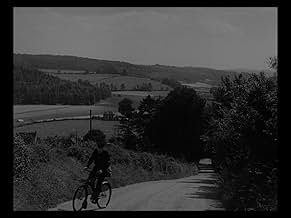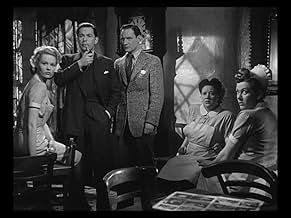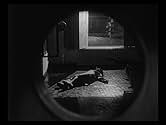NOTE IMDb
7,4/10
6 k
MA NOTE
Après la mort d'une infirmière qui avait signalé un meurtre sur la table d'opération, un inspecteur énigmatique de Scotland Yard vient enquêter.Après la mort d'une infirmière qui avait signalé un meurtre sur la table d'opération, un inspecteur énigmatique de Scotland Yard vient enquêter.Après la mort d'une infirmière qui avait signalé un meurtre sur la table d'opération, un inspecteur énigmatique de Scotland Yard vient enquêter.
- Réalisation
- Scénario
- Casting principal
- Récompenses
- 2 victoires au total
Richard Duke
- Orderly
- (non crédité)
Ronald Ward
- Bit Part
- (non crédité)
Avis à la une
By gum, from the 1940's through the 1960's, when the British put together a murder mystery with a psychological edge, nobody could beat them! This little thriller starts out in WWII as a team of surgeons and nurses are quite busy repairing the bodies of people hit by Nazi planes whose targets are not military but civilian in an effort to beat down the morale of British citizens.
One night a fellow named Higgins is brought in, badly injured by one of these Nazi bombs, and he dies on the operating table. He says something right before he goes under the anesthetic to one of the members of the team - I won't tell you what - and you think "Oh this is easy, THAT person did it." Then you find out another member of the team has psychological issues stemming from her mother's death in a raid while she was away from home, that there are jealousy issues over a woman between the two doctors, and yet another member of the team just likes to cause trouble.
Big tip here - if you suspect that someone is guilty of murder, do not stop a social event in a room that includes all of the suspects and say "I know there has been a murder, I know who the murderer is, and I am now going alone out into the dark of night to retrieve the evidence that will convict that person!" You will wind up dead, and so does that person.
Enter stage left Alistair Sim as a representative of Scotland Yard -in other words a cop - and he is every bit as unlikeable as any murderer could be. He announces that Higgins was murdered, he announces that the five surviving members of the surgical team are suspects, and he also announces that four poison pills are missing from the pharmacy. The implication is that the one of the five that is the murderer plans to kill the other four. On his way to solving the case, Sims' character seems to really enjoy making women cry hysterically and causing the doctors to come to blows with only words and insinuations.
There will be several places right up to the end where you are SURE you know who is guilty and you will be wrong right up to the ironic ending. Watch and find out who did it and why. I guarantee you'll be on the edge of your seat right up to the end, which is when the confusing title of this film is explained.
One night a fellow named Higgins is brought in, badly injured by one of these Nazi bombs, and he dies on the operating table. He says something right before he goes under the anesthetic to one of the members of the team - I won't tell you what - and you think "Oh this is easy, THAT person did it." Then you find out another member of the team has psychological issues stemming from her mother's death in a raid while she was away from home, that there are jealousy issues over a woman between the two doctors, and yet another member of the team just likes to cause trouble.
Big tip here - if you suspect that someone is guilty of murder, do not stop a social event in a room that includes all of the suspects and say "I know there has been a murder, I know who the murderer is, and I am now going alone out into the dark of night to retrieve the evidence that will convict that person!" You will wind up dead, and so does that person.
Enter stage left Alistair Sim as a representative of Scotland Yard -in other words a cop - and he is every bit as unlikeable as any murderer could be. He announces that Higgins was murdered, he announces that the five surviving members of the surgical team are suspects, and he also announces that four poison pills are missing from the pharmacy. The implication is that the one of the five that is the murderer plans to kill the other four. On his way to solving the case, Sims' character seems to really enjoy making women cry hysterically and causing the doctors to come to blows with only words and insinuations.
There will be several places right up to the end where you are SURE you know who is guilty and you will be wrong right up to the ironic ending. Watch and find out who did it and why. I guarantee you'll be on the edge of your seat right up to the end, which is when the confusing title of this film is explained.
The British film industry has had a chequered history, but was arguably at its finest in the 40's and 50's when it produced little gems like this.
Straightforwardly plotted convergent mysteries of this genre, with or without a major twist, never fail to give simple satisfaction when acted by such a cast of stalwarts and regular journeypersons as we find here. Some may find the stiff upper lips and well modulated tones of the middle classes a little grating for modern tastes, where nurses all speak naicely and ordinary folk are played by caricature cockneys. Speaking of stiff upper lips, their very personification Trevor Howard is, of course, in it, playing a surgeon with a cloud over his career. Which is why the whole is leavened by the unique figure of Alastair Sim.
No matter how serious the role he must play, his lugubrious features invariably betray an innate whimsicality, that essence of grown-up-naughty-schoolboy that we find so universally engaging, and which is the world's view of Britishness at its best. He makes it possible to insert a pratfall or quip to lighten the atmosphere without losing it.
Films like this were very easy and cheap to make - minimal locations, scenery munching, explosions or car wrecks. Current film makers might take note of their bang-per-buck in an era when nostalgic baby boomers are making their cinema presence felt again. But where will they find another Alastair Sim?
Straightforwardly plotted convergent mysteries of this genre, with or without a major twist, never fail to give simple satisfaction when acted by such a cast of stalwarts and regular journeypersons as we find here. Some may find the stiff upper lips and well modulated tones of the middle classes a little grating for modern tastes, where nurses all speak naicely and ordinary folk are played by caricature cockneys. Speaking of stiff upper lips, their very personification Trevor Howard is, of course, in it, playing a surgeon with a cloud over his career. Which is why the whole is leavened by the unique figure of Alastair Sim.
No matter how serious the role he must play, his lugubrious features invariably betray an innate whimsicality, that essence of grown-up-naughty-schoolboy that we find so universally engaging, and which is the world's view of Britishness at its best. He makes it possible to insert a pratfall or quip to lighten the atmosphere without losing it.
Films like this were very easy and cheap to make - minimal locations, scenery munching, explosions or car wrecks. Current film makers might take note of their bang-per-buck in an era when nostalgic baby boomers are making their cinema presence felt again. But where will they find another Alastair Sim?
Directed and produced by Sidney Gilliat and Frank Launder, the British mystery-comedy Green for Danger is a rare treat. Featuring the incomparable Alastair Sim as Cockrill, a bumbling Scotland Yard detective and the redoubtable Trevor Howard as a suspicious doctor, the plot is a convoluted murder mystery in which five people have motive and means to commit murder -- but whodunit?
Set in a rural British hospital (that looks like an Elizabethan mansion) during the latter stages of World War II, two people are murdered before you can say "buzz bomb". The first suspicious death occurs when a postman suddenly dies on the operating table after receiving an anaesthetic. This is soon followed by the death of Nurse Marion Bates (Judy Campbell) after she announces at a party that she has found evidence to expose the killer. The possible killer includes the uptight Dr. Barnes (Trevor Howard), the emotionally unstable Nurse Sanson (Rosamund John), Nurse Woods (Megs Jenkins), Nurse Linley (Sally Gray), the object of affection from both doctors, and the philandering surgeon, Mr. Eden (Leo Genn). Each one of the suspects looks and acts guilty.
There are many twists and turns and, without giving anything away, a staged mock operation after an attempted third murder ultimately will tell the tale. But the film belongs to Alastair Sim. The word whimsical must have been invented with him in mind. You just cannot take things too seriously when he is around. His capricious charm and impudent smile lights up every dark shadow in the old hospital. Green for Danger is a bit stodgy but lots of fun.
Set in a rural British hospital (that looks like an Elizabethan mansion) during the latter stages of World War II, two people are murdered before you can say "buzz bomb". The first suspicious death occurs when a postman suddenly dies on the operating table after receiving an anaesthetic. This is soon followed by the death of Nurse Marion Bates (Judy Campbell) after she announces at a party that she has found evidence to expose the killer. The possible killer includes the uptight Dr. Barnes (Trevor Howard), the emotionally unstable Nurse Sanson (Rosamund John), Nurse Woods (Megs Jenkins), Nurse Linley (Sally Gray), the object of affection from both doctors, and the philandering surgeon, Mr. Eden (Leo Genn). Each one of the suspects looks and acts guilty.
There are many twists and turns and, without giving anything away, a staged mock operation after an attempted third murder ultimately will tell the tale. But the film belongs to Alastair Sim. The word whimsical must have been invented with him in mind. You just cannot take things too seriously when he is around. His capricious charm and impudent smile lights up every dark shadow in the old hospital. Green for Danger is a bit stodgy but lots of fun.
With its darkly atmospheric tones,Green for danger works extremely well.The second murder is incredibly well shot with scenes reminiscent of 'I walked with a Zombie',the noise & movement caused by wind being particularly effective.A stellar cast interact perfectly with a special mention for Sally Gray,on her first role after a 5 year break due to 'a mental breakdown',comes across as a glacial goddess.I'm not worthy.Alistair Sim's lugubrious narration provides a perfect framing device building a sense of anticipation and atmosphere.I don't find the movie slow and I was surprised that people find it 'talkie',maybe its modern audiences with their legendary short attention span!
The quintessential 40s British whodunit, Green for Danger satisfies even as it leaves a trail of plot holes that even Alistair Sims' rather self-satisfied Inspector Cockrill would have spotted. Perhaps it satisfies despite its flaws because it embodies all the good things about British films back then. The writers assume a level of intelligence on the part of their viewers and possession of an attention span that would seem unattainable to many of today's MTV generation. Time is taken to develop characters and establish relationships instead of telling the audience everything about a character that is necessary only for the purpose of driving the plot along.
Alistair Sim, sporting a typically smug grin when he's not ducking airplanes, plays Inspector Cockrill, who is called upon to investigate the murder of a postman on the operating table at a quaint hospital full of wooden beams and flagstone floors. He doesn't appear until midway through the film – although his voice can be heard on the narration from the outset – and his dry wit peps things up immeasurably. We are presented with the usual group of suspects: Leo Genn as a vaguely slimy Lothario who wastes no time in pursuing the lovely nurse Fredericka (Sally Gray) the moment she breaks off her engagement to a young Trevor Howard; buxom Megs Jenkins, a matronly figure even then although she was still in her twenties, and a nurse who borders on the edge of hysteria nearly all the time. They were all present at an operation in which poor old Moore Marriott was pumped full of Co2, and are all, therefore, suspected of his murder.
The film keeps you guessing throughout – knowing very little about the film before I watched it, I couldn't even figure out who the second victim was going to be for a while: the plot seemed to be setting up one character for the fall before turning the spotlight on someone else entirely. A couple of red herrings throw you off the trail quite nicely, and Inspector Cockrill's confidence proves to be monumentally misplaced. The twist at the end is truly sublime, and the look on Alistair Sim's face when all becomes clear is one of those cinematic moments that live long in the memory. It's all very quaint and old-fashioned now, but it still provides some solid entertainment.
Alistair Sim, sporting a typically smug grin when he's not ducking airplanes, plays Inspector Cockrill, who is called upon to investigate the murder of a postman on the operating table at a quaint hospital full of wooden beams and flagstone floors. He doesn't appear until midway through the film – although his voice can be heard on the narration from the outset – and his dry wit peps things up immeasurably. We are presented with the usual group of suspects: Leo Genn as a vaguely slimy Lothario who wastes no time in pursuing the lovely nurse Fredericka (Sally Gray) the moment she breaks off her engagement to a young Trevor Howard; buxom Megs Jenkins, a matronly figure even then although she was still in her twenties, and a nurse who borders on the edge of hysteria nearly all the time. They were all present at an operation in which poor old Moore Marriott was pumped full of Co2, and are all, therefore, suspected of his murder.
The film keeps you guessing throughout – knowing very little about the film before I watched it, I couldn't even figure out who the second victim was going to be for a while: the plot seemed to be setting up one character for the fall before turning the spotlight on someone else entirely. A couple of red herrings throw you off the trail quite nicely, and Inspector Cockrill's confidence proves to be monumentally misplaced. The twist at the end is truly sublime, and the look on Alistair Sim's face when all becomes clear is one of those cinematic moments that live long in the memory. It's all very quaint and old-fashioned now, but it still provides some solid entertainment.
Le saviez-vous
- AnecdotesThe lines quoted by Inspector Cockrill and Mr Eden come from William Shakespeare's 'The Merchant of Venice', Act 5 Scene 1.
- GaffesAs the movie takes place in 1944 whilst Britain is being attacked by V1 bombs ('doodlebugs'), the windows and glass doors in the hospital should have been taped to prevent glass being shattered by an explosion and blowing in on people inside.
- Citations
Dr. Barnes: I gave nitrous oxide at first, to get him under.
Inspector Cockrill: Oh yes, stuff the dentist gives you, hmmm... commonly known as "laughing gas."
Dr. Barnes: Used to be... actually the impurities cause the laughs.
Inspector Cockrill: Oh, just the same as in our music halls.
- ConnexionsFeatured in TCM Guest Programmer: Thelma Schoonmaker (2007)
Meilleurs choix
Connectez-vous pour évaluer et suivre la liste de favoris afin de recevoir des recommandations personnalisées
Détails
- Date de sortie
- Pays d’origine
- Langues
- Aussi connu sous le nom de
- Green for Danger
- Lieux de tournage
- Société de production
- Voir plus de crédits d'entreprise sur IMDbPro
Box-office
- Budget
- 202 400 £GB (estimé)
- Durée1 heure 31 minutes
- Couleur
- Rapport de forme
- 1.37 : 1
Contribuer à cette page
Suggérer une modification ou ajouter du contenu manquant

Lacune principale
What is the Brazilian Portuguese language plot outline for La couleur qui tue (1946)?
Répondre































